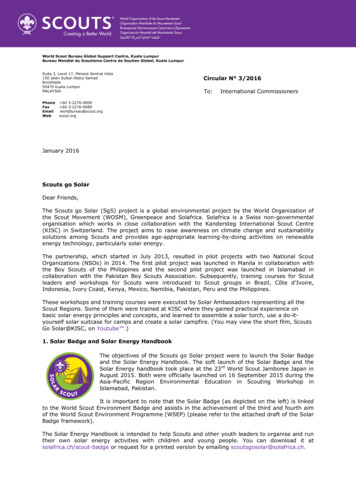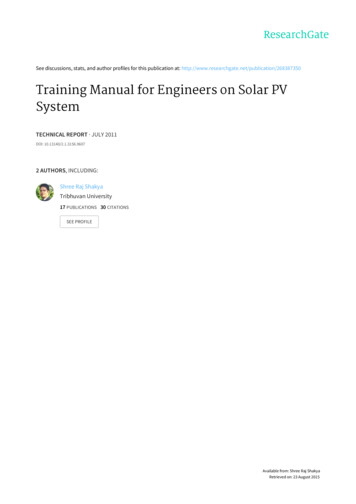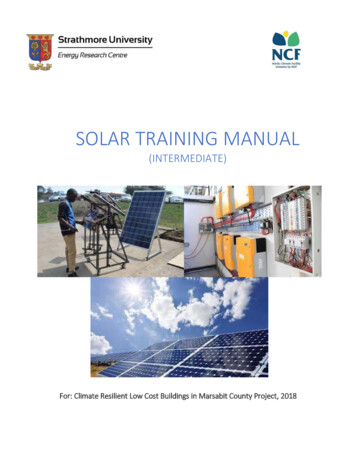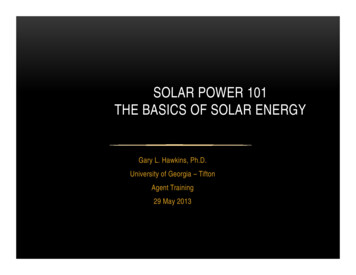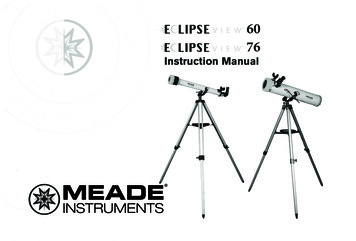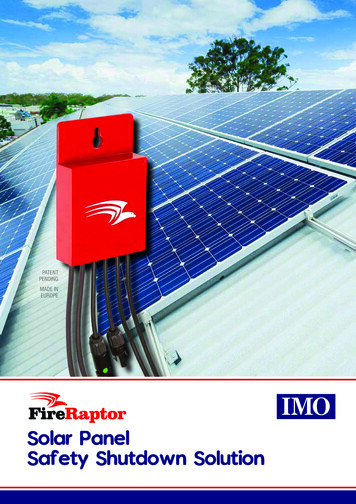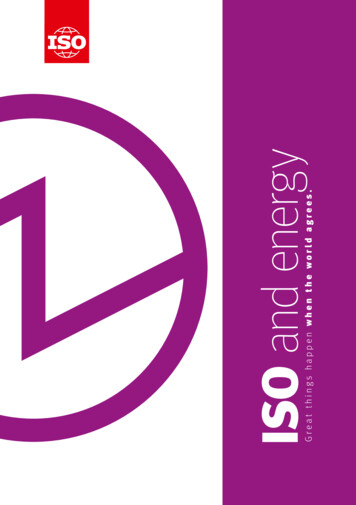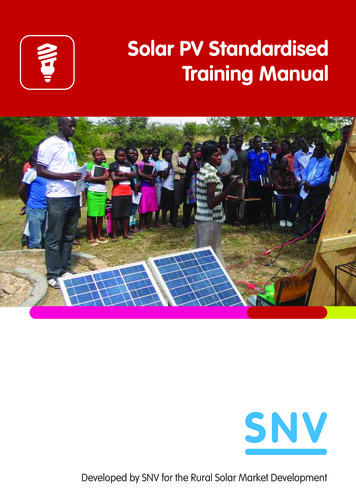
Transcription
Solar PV StandardisedTraining ManualDeveloped by SNV for the Rural Solar Market Development
PreambleThis Solar PV Standardised Training Manual has been developedby SNV Zimbabwe to provide basic technical training in the sizing,installation and maintenance of photovoltaic systems. In addition,it is a post training referral resource in troubleshooting andmaintenance of systems. The manual covers the following:a)b)c)d)e)f)Introduction to renewable energy in ZimbabweElectricity basicsSolar energy principles and applicationsPhotovoltaic technology and applicationSystem sizingSafety precautions, basic maintenance andtrouble shootingThe manual is designed for use by anyone who wishes todevelop his/her technical knowledge in PV. However, it isparticularly targeted at those who wish to engage in thebusiness of supplying and installing PV products. This manualdoes not guarantee the quality of installations carried out bytrainees. It is recommended that all installations are carriedout in a responsible and professional way. All electrical workshould be performed by a qualified electrician to guaranteethe installation and/or repairs.About SNVSNV is a not-for-profit international development organisation.Founded in the Netherlands nearly 50 years ago, we have builta long-term, local presence in 38 of the poorest countries in Asia,Africa and Latin America. Our global team of local and internationaladvisors work with local partners to equip communities, businessesand organisations with the tools, knowledge and connections theyneed to increase their incomes and gain access to basic services– empowering them to break the cycle of poverty and guidetheir own development.Through its Renewable Energy arm, SNV Zimbabwe hasimplemented the Rural Solar Market Development Projectcontributing to the success of most of its private sectorpartners’ rural distribution capacities. The project hasalso helped partners to offer innovative next-generationsolutions for efficient use of solar energy todayand in the future.
CONTENTSUnit 1: An Introduction to RenewableEnergy in ZimbabweIntroductionEnergy Challenges in ZimbabweStatus of Renewable Energy in ZimbabweSolar Energy in ZimbabweUnit 1 Exercises0505060912Unit 2: Solar Energy - The Basic PhysicsA Brief Introduction to ElectricityThe Solar ResourceSolar Energy ConversionUnit 2 Exercises15192123Unit 3: Photovoltaic SystemsFrom Micro PV to Utility ScalePV System ComponentsSolar LanternsSolar Home SystemsUnit 3 Exercises2525363940Unit 4: Solar Home System SizingIntroduction to system sizingA Sample Design SituationSteps in System Sizing ProcessLoad Assessment- PV Module Sizing- Battery Sizing- Charge Controller Sizing- Inverter Sizing- Wire SizingSunshine Hours MethodUnit 4 Exercises01Solar PV Standardised Training Manual4343445052
Unit 5: PV System InstallationSite AssessmentPreparation for installationPV Array InstallationConnection of the Charge ControllerBattery InstallationUnit 5 Exercises555556596265Unit 6: Solar Water PumpingIntroduction to Basic Solar Water PumpingApplications of Solar Water PumpingMain Components of the Solar WaterPumping SystemSizing & Designing a Solar WaterPumping SystemInstallationUnit 6 ExercisesTips For Using This ManualThe following tools are included to aidin detailed training:1.6768682.3.727475For quick reference the following areprovided:1.Unit 7: Safety Precautions, Basic Maintenance& Trouble Shooting Of PV SystemsSite Risk and Hazard AssessmentSafety PrecautionsMaintenance of System ComponentsUnit 7 Exercises & Troubleshooting Guidance77818286Frequently Asked Questions (FAQs)87Appendix91Worked examples to test trainees’grasp of concepts.Practical exercises to aid traineesin putting theory into practice.Graphics to illustrate conceptsand applications.2.Highlighted Do’s and Don’ts forcare and maintenance of systemcomponents.A list of FAQsThis manual is meant to be usedhand-in-hand with the Solar PVReferral Manual and its accompanyingPullOut Booklet.Solar PV Standardised Training Manual02
ABBREVIATIONS CDegrees CelciusAAmperesACAlternating CurrentAhAmpere hoursDCDirect CurrentEEnergyFAQFrequently Asked QuestionGWhGigawatt hourICurrentkWKilowattkWhKilowatt hourm/sMetres per secondMJMegajouleMWMegawattNGONon-Governmental nceREARural Electrification AgencySHSSolar home systemSTCStandard Test ConditionsTVTelevisionVVoltsW/m2Watts per square metreWhWatt hourLIST OF VISUAL AIDSTable 1: Feasible SHP sites on existing damsTable 2: Design Situation InformationTable 3: Mutare Average Monthly Daily Insolation & Earth TempTable 4: Load AssessmentTable 5: Typical 200W PV Module CharacteristicsTable 6: Wire Sizing Chart084344444549Images 1, 2, 3 & 4: Solar refrigeration, Solar water heater, Solarmilk pasteurizer & Solar crop dryerImage 5: Solar Calculator versus Solar FarmImage 6: Typical Solar CellImage 7:Charge ControllerImages 8, 9 & 10: Other Examples of Charge ControllersImage 11: Pure Sine Wave InverterImage 12: Location of DC & AC Loading TerminalsImage 13: Charge controller terminalsImage 14: Charge controller connectionsImage 15: Battery connection terminalImage 16: Solar Panel connection terminalImage 17: Solar water pumping systemImages 18 & 19: Examples of surface & submersible water pumps09Figure 1: Visual representation of the difference between AC & DCFigure 2: Simple Schematic Drawing of a CircuitFigure 3: Series Connection SchematicFigure 4: Parallel Connection SchematicFigure 5: Solar cell, module, array and solar generatorFigure 6: Extract of a name plate of a solar panelFigure 7: Connections on a charge controllerFigure 8: Solar lantern schematic layoutFigure 9: PV Array to DC LoadFigure 10: Schematic of stand-alone PV systemFigure 11: PV Module Size FormulaFigure 12: PV Module Size Final CalculationFigure 13: Battery Capacity CalculationsFigure 14: Inverter Sizing CalculationsFigure 15: Series type connection of solar panelsFigure 16: Parallel connection of solar panelsFigure 17: Schematic of battery connected to a solar systemFigure 18: Series Connection of BatteriesFigure 19: Parallel Connection of BatteriesFigure 20: Surface water pumpFigure 21: Submersible water pumpFigure 22: Battery-Coupled Solar Water Pumping SystemFigure 23: Direct-Coupled Solar Water Pumping SystemFigure 24: Illustration of the Vertical 73Illustration 1: Earth’s Solar BudgetIllustration 2: How a Solar Panel WorksIllustration 3: Solar Panel to Heat WaterIllustration 4: Shading of solar panelsIllustration 5: Site Risks & hazard assessment1921225677Map 1: Sunshine Hours per day In ZimbabweMap 2: Latitude & Longitude map of Zimbabwe2057252628293434595960616769
UNIT 1:An Introductionto RenewableEnergy inZimbabweLearning OutcomesBy completing this unit, trainees will have basicunderstanding of:i.ii.iii.iv.The various sources of energy andthe differences between the renewableand non-renewable energy technologiesThe energy situation in Zimbabweincluding electrification rates, and thecontribution of the different energyresources to the energy supply of thecountry.The basics of solar energy technologiesand their applicationThe advantages and disadvantages ofsolar technologyIn this Unit 01Youth Enterprise Development Solar PV Standardised Training ManualEnergy Challenges in ZimbabweStatus of Renewable Energy in ZimbabweSolar Energy in ZimbabwePros and Cons of Solar Energy
IntroductionHeading 2The existence of life on earth requires energy in its various forms. Ultimately, directly or indirectly,the sun provides all the power we need to exist and supports all life forms.From solar ovens to solar panels, solar energy has been harnessed by humans since the beginningof human history. As far back as the 5th century, humans were constructing homes and buildings tomaximize use of energy from the sun. Today, we know the sun as our closest star in the universe.This ball of gas has a large build-up of heat and pressure in its core that causes it to emit heat andradiant energy. More energy from the sun falls on the earth in one hour than humans consume inone year.Unlike various forms of conventional (non-renewable) sources of energy such as coal, oil or naturalgas, solar energy is a renewable form of energy, along with biomass, hydro, waste and wind. Thougha variety of technologies have been developed to take advantage of solar energy in recent years,solar power accounts for less than one percent of electricity use in the Zimbabwe. However, giventhe abundance of solar energy and its popular appeal, this resource is likely to play a prominentrole in our energy future.Energy Challenges in ZimbabweOnly 37% of Zimbabwe’s population has access to electricity. Of the ruralpopulation, just 13% has access to electricity, mainly accounted for by growthpoints, business centres and mission stations. The statistics show that the poorare not connected to the grid and as such end up spending more on energythan the rich. The most recent national energy balance study (2009) showsthat biomass contributes about 61% of the national energy consumption whileelectricity contributes just above 13%. Forests are disappearing very fast,causing desertification thus threatening the country and region’s food security.Moreover, forests are carbon sinks and their disappearance contributes toglobal warming. Decentralised renewable energy schemes have the potentialto meet the social and economic energy demands for the rural population ina sustainable manner.Levels of investment in Zimbabwe’s electricity generation sector are low due topolitical and economic reasons. Some of the existing power plants are operatingat very low capacities for various reasons, some of which are:(i)(ii)(iii)(iv)Some power stations are operating beyond their life spansFrequent breakdowns due to ineffective / lack of maintenanceand ageing of equipment and infrastructureInadequate coal suppliesShortage of qualified and experienced manpowerSolar PV Standardised Training Manual05
Unit 1: An Introduction to Renewable Energy in ZimbabweThe main cause of low investment in power generation is scarcity of capital for buildingnew power plants, refurbishing of existing power plants and importing energy equipmentand electricity. The economies of the countries which used to supply Zimbabwe withelectricity have grown so much that they no longer have much to spare. Furthermore,Zimbabwe does not have the capacity to produce energy system components locally apartfrom batteries and other accessories resulting in an unsustainable over reliance on imports.Status of Renewable Energy in ZimbabweResearch has shown that the country has enormous energy resources which far exceedenergy requirements. Most of these resources are grossly underutilized, particularly naturalgas, hydro resources and the abundant solar energy available throughout the year. Thusthe problem is not lack of energy resources but its development and utilization. The countryhas the potential to become a major net exporter of energy for several decades to come.Despite having significant renewable energy resources, the large power stations (with theexception of hydro power plants including Kariba) tend to be coal powered. As such,there is significant opportunity for electricity in Zimbabwe to be generated mainlyfrom renewable energy sources.Biomass FuelsUnprocessed plant material combusted for the generation of heatThe traditional use of biomass is the burning of firewood for cooking and space heating.However, there are more sustainable means of using biomass for energy generation.Agricultural production can lead to large quantities of biomass, as at Triangle and HippoValley Estates where sugarcane bagasse is used to contribute significantly to theirelectricity needs, with the excess exported to the national power grid. The plants havecapacity to produce 150MW with technological improvements and shift of business focusfrom disposing the bagasse to efficient electricity generation. Olivine Industries is knownto be firing two of its boilers using waste from cotton seed de-hulling.Sawmills in the eastern part on the country produce a lot of sawmill dust (about 50PJ/year)which can be burnt to generate electricity. Forest residue from commercial forests isestimated at 70,000 tonnes and has potential for the generation of 150MW power andthe creation of a more formalised wood fuel and charcoal market. Three companies –Allied Timbers, Border Timbers and The Wattle Company – generate over 40,000m of pine waste per year.BiofuelsFuel produced by processing plant material such as JatrophaThe Government has made a policy decision to embark on a programme to produce anduse bio-diesel. Bio-diesel production in Zimbabwe offers improved energy security, importsubstitution, employment opportunities, empowerment and poverty alleviation in rural06Solar PV Standardised Training Manual
areas, reclamation and rehabilitation of degraded lands. The national bio-diesel productionprogramme is based on Jatropha Curcas L as the feedstock material. The bio-diesel plantinstalled at Mount Hampden, near Harare is believed to be the largest such plant in Africa.Efforts should be directed at ensuring the efficient operation of the plant and ensure aconsistent supply of raw material at a reasonable cost.EthanolFuel produced by processing of sugar caneTriangle Ltd’s enthanol plant resumed production in 2008 following refurbishment. In 2009,the plant produced 1 million litres of fuel grade ethanol. The refurbishment cost over 3million. The Zimbabwean Government, in partnership with two investors has embarkedanother ethanol project valued at 600 million at the Agricultural and Rural DevelopmentAuthority (ARDA) estates in Chisumbanje. The project will use 20,000 hectares of sugarcaneplantations to provide 80% of Zimbabwe’s ethanol needs and supply electricity (30 MW)to Mutare and several parts of Manicaland province.Ethanol Gel Fuel, a compound of ethyl alcohol (ethanol) and organic pulp (cellulose) isanother important source of household and institutional fuel that has been introduced onthe Zimbabwean market. The calorific value of gel fuel compares favourably with that ofparaffin. Access of households to paraffin has been hit by supply shortages. Given that themajor raw material of gel fuel (ethanol) is locally produced, it becomes a more economicoption as a substitute for the imported paraffin. Ethanol gel is considered to be a ‘greenfuel’ because not only is it renewable, but is also manufactured entirely from organiccompounds hence its combustion results in no net carbon dioxide emissions.WindUse of wind’s mechanical energy (captured using turbines) to pump water or generateelectricityIn Zimbabwe wind speeds are generally low (about 3m/s) but can be used for waterpumping and driving grinding mills. Electricity can be produced at small power levels (1to 100kW) and from hybrid systems with micro photovoltaic generators for isolated sitesin rural areas.Wind energy technology development has a more attractive investment potential as itoffers less capital investment than hydro and thermal power generators, because winddriven turbines generate electricity as soon as they are installed, unlike hydro and thermalpower generators which require more infrastructural development. A small wind farm wasestablished at Temaruru Business Centre near Rusape and six wind turbines of 1kwh wereinstalled to power shops.Solar PV Standardised Training Manual07
Unit 1: An Introduction to Renewable Energy in ZimbabweSmall HydropowerUse of mechanical energy in flowing water (captured using turbines) to pump water orgenerate electricityIn some areas of Zimbabwe, particularly in the Eastern Highlands, feasibility studies thathave been carried out show that there are a number of perennial rivers with sufficientcapacity that can be tapped for mini-hydro power development. Potential also exists atmany irrigation dams throughout Zimbabwe to develop small-scale hydroelectric projectsto partially offset the energy importation requirements of the country. To date only 7hydropower generation schemes have been constructed in the eastern highlands, withpower output ranging from 8 kW to 700 kW. One scheme with 700kW power generationis connected to the national grid. Tables 1&2 give minihydro potential on dams andperennial rivers.Table 1:Feasible SHP siteson existing damsDAMCAPACITY (MW)CAPACITY andMuturikwi (Kyle)5.03.7ManicalandBangala1.09.0ManicalandNgezi (Palawan)0.32.0Zvishavane / vingoBiogasMethane produced by anaerobic digestion of organic waste matter such as animalwaste and agricultural wasteThe Government has built biogas plants as demonstration projects at institutions,communities and exhibition centres; others are also in use on commercial farms. Itis envisaged that biogas will play a major role in providing alternative source of energyin smallholder farming areas, commercial farms, boarding schools and similar ruralinstitutions for cooking, lighting and refrigeration. Currently the country has more than400 biogas digesters scattered countrywide. Focus is on smallholder farmers and resettledareas. Constraints in the dissemination of the technology are to do with lack of end-userfinancing, limited number of trained builders compared to the demand for digesters.08Solar PV Standardised Training Manual
Recently NGOs have shown a lack of willingness to finance projects on bio-digestersowing to high levels of failures in many of the installed bio-digesters.Municipalities of some towns such as Harare have bio-digesters for anaerobic sludgetreatment where a small proportion of the gas is used for heating sludge and most of thegas produced is just flared into the atmosphere. There is need for municipalities to installcombined heat and electricity generating plant to maximise producer gas use.Solar Energy in ZimbabweThe country’s solar energy potential of 16–20MJ/m /day is greatly underexploited. At 3,000hours a year, this can produce 10,000GWh of electrical energy per year. Donor-funded solarPV (photovoltaic) installations have been installed in many homes, businesses, schools andhealth centres since the launch of the Global Environment Fund initiative in the early 1990s.In addition to the Rural Electrification Agency (REA), there are a lot of small and mediumenterprises now involved in importing and installing solar home systems for individuals whocan afford buying the equipment.Solar PV water pumping systems are also becoming a big area of interest. Solar waterheaters present an attractive alternative technology for heating water both for domesticand industrial applications. The electricity saved by displacing electric water heating systemsresults in less pressure on the national grid and lower electricity bills for heating purposes.The electricity so saved can also be diverted to more productive uses in industry. Solarwater heating technology is now a common technology in both urban and rural areas.Mining establishments with financial resources (e.g. Mimosa Mining Company inZvishavane) have installed Solar Water Heaters in many of its staff houses.Other types of solar thermal applications such as drying of vegetables and fruit,pasteurization of liquid foodstuffs, water desalination, cooking and water heatingare also common.01030402Image 1: Solar refrigerationImage 2: Solar water heater (evacuated tube solar geyser)Image 3: Solar milk pasteurizerImage 4: Solar crop dryerSolar PV Standardised Training Manual09
Unit 1: An Introduction to Renewable Energy in ZimbabwePros and Cons of SolarAdvantages of Solar PV Technology1.2.3.4.5.6.7.8.Solar PV provides clean – green energy. During electricity generation withSolar PV there are no harmful greenhouse gases that are emitted thus itbecomes environmentally friendly.Solar energy is energy supplied by nature – it is thus free and abundant!Solar energy can be made available almost anywhere there is sunlightSolar PV technology has indeed a highly promising future both foreconomical viability and environmental sustainability.Photovoltaic panels, through photoelectric phenomenon, produce electricityin a direct electricity generation way.Operating and maintenance costs for PV panels are considered to be low,almost negligible, compared to costs of other renewable energy systems.PV panels have no mechanically moving parts, except in cases ofsun-tracking mechanical bases; in addition they have less breakages andrequire less maintenance than other renewable energy systems (for examplewind turbines).PV panels do not produce any noise at all.Disadvantages of Solar PV1.2.3.4.5.6.7.10Solar PV Standardised Training ManualAs in all renewable energy sources, solar energy has is not alwaysavailable, there is no sun shining at night, during cloudy and rainy days.Consequently, intermittency and unpredictability of solar energy makessolar energy panels less reliable a solution.Solar energy panels require additional equipment (inverters) to convertdirect electricity (DC) to alternating electricity (AC) in order to be used on thepower network.For a continuous supply of electric power, especially for on-gridconnections, Photovoltaic panels require not only Inverters but also storagebatteries; thus increasing the investment cost for PV panels considerablyIn case of land-mounted PV panel installations, they require relativelylarge areas for deployment; usually the land space is committed for thispurpose for a period of 15-20 years – or even longer.Solar panels efficiency levels are relatively low (between 14%-25%)compared to the efficiency levels of other renewable energy systems.Though PV panels have no considerable maintenance or operating costs,they are fragile and can be damaged relatively easily; additional insurancecosts are therefore of ultimate importance to safeguard a PV investment.
CONSPROSSummary of Pros & Cons of SolarReliabilityEven in harsh conditions, PV systems will continue to generate power,preventing costly power failures where continuous operation is critical(e.g. solar refrigeration in a butchery)DurabilityMost modules are guaranteed from the manufacturer to produce powerfor 25 years and will keep producing well beyond that timeframeLow MaintenanceCostsPV systems only require periodic inspection and occasional low costmaintenance such as dust removal on panels.No fuel costsNo fuel required therefore there are no costs associated with purchase,storage and transportation of fuel.Reduced soundpollutionPV systems do not have moving parts and therefore operate silentlyFlexibility dueto modularityModules can be added incrementally to increase power available fromthe systemSafetyPV systems do not require combustible fuels and therefore are safe whenproperly designed and installedIndependenceIndependence from unreliable grid supplied powerGriddecentralisationSmall scale decentralised power stations reduce the possibility of outageson the electricity gridHigh altitudeperformanceIncreased insolation at high altitudes leads to optimised power output.In contrast, generators need to be de-rated at high altitudes.Initial costHigher installation costs compared with generators. Prices are however,coming downVariabilityWeather can affect the power output of solar based systemsEnergy storageThe need for batteries increases the size, cost and complexity of systems.In addition energy storage technology still needs to develop furtherEfficiencyimprovementsA cost-effective use of PV requires use of energy efficient applianceswhich may require replacement of inefficient appliancesEducationUptake of PV technology needs to go hand in had with user educationas the technology is new to most in rural areas.Solar PV Standardised Training Manual11
UNIT 1 EXERCISESExercises1.Define the following terms:a.Biofuelsb.Small hydro powerc.Biogas2.Name three non-renewable sources of energy.3.Name three renewable sources of energy.4.What energy source is used to meet the highestproportion of energy demand in Zimbabwe?5.6.List four applications of solar technology in Zimbabwe.What is the main barrier to the development of renewableenergy in Zimbabwe?7.Why is solar energy an appropriate technology for Zimbabwe?List four reasons.Practical Exercise:Over the next week, identify, take note and take photographs (if possible) of solar technology at workaround your everyday environs. This will aid in your appreciation of the application of the technology.Practical Exercises12Solar PV Standardised Training Manual
UNIT 2:Solar Energy– The BasicPhysicsLearning OutcomesBy completing this unit, trainees will have basicunderstanding of:i.ii.iii.iv.The basics of electricity – voltage,current, resistance, power and energyDescribe solar energyThe earth’s energy budgetThe technology enabling the captureand use of solar power (solar PV andsolar thermal)In this Unit 01Youth Enterprise Development Solar PV Standardised Training ManualA Brief Introduction to ElectricityThe Solar ResourceSolar Energy Conversion
A Brief Introduction to ElectricityWhat is Electricity?Heading 2The term electricity is used generically in reference to four related physical states as follows:1.Electric charge: the build up of electrical energy measured in coulombs.Naturally it occurs as static electricity. Batteries store electric charge.2.Electric current: the rate of flow of electric charge measured in amperes3.Electric potential: the potential difference in electrical energy between two pointse.g. between the positive and negative terminals of a battery. It is measured in volts.4.Electromagnetism: the relationship between electricity and magnetism, whichenables electrical energy to be generated from mechanical energy (as in a generator)and vice versa (as in a motor).Measuring Electricity Power (P):the rate of energy conversion measured in Watts Voltage (V):the potential difference in electrical charge betweentwo points measured in Volts Current (I):the flow of electrons in a circuit/wire between twopoints measured in Amperes Resistance (R):the opposition to the flow of electrical current in thematerial through which it is passing measured in Ohms Energy (E):refers to the capacity for work i.e. the power usedover time, measured in Watt hoursSolar PV Standardised Training Manual15
Unit 2: Solar Energy - The Basic PhysicsThe following equations show the relationship between the above parameters:Power Volts x CurrentP VXIWattsVolts Power CurrentV P IVoltsCurrent Power VoltsI P VAmperesResistance Volts CurrentR V IOhmsEnergy Power x TimeE PxtWatt-HoursTypes of CurrentDC VoltageVoltageIn electricity generation there are two distinct types of electrical current - direct current(DC) and alternating current (AC).Alternating current is the type of current most commonly used in households to powerelectrical appliances (for example TVs, refrigerators, radios and computers). Grid suppliedelectricity is alternating current.TIMEVoltageDirect current is produced by PV modules and stored in batteries.AC VoltageTIMEFigure 1:Visual Representation of thedifference between AC and DC16Solar PV Standardised Training ManualIt is possible to convert direct current to alternating current and vice versa using an adapter(e.g. cell phone charger) or an inverter (see Unit 3). Some key differences between AC andDC are shown in Table 2 below.Alternating CurrentDirect CurrentAmount of energythat can be carriedSafe to transfer over longerdistances and can providemore power.Cannot travel very far untilvoltage drop will start toaffect, hence there will beloss of energy.FrequencyThe frequency of alternatingcurrent is 50Hz or 60Hz, asindicated on most appliancesThe frequency is zero.DirectionReverses its direction atfrequent, regular intervalswhile flowing in a circuit.Flows in one direction in acircuit.CurrentIt is the current of magnitudevarying with timeIt is the current of constantmagnitude.Flow of electronsElectrons keep switchingdirections - forward andbackward.Electrons move steadily in onedirection or 'forward'.Obtained fromA.C Generator and mains.Cell or Battery.StorageCannot be storedCan be stored in batteries.
On some electrical devices DC and AC Voltage are represented by signs as follows (these arethe signs that are used on most multimeters to indicate the two l CircuitsAn electrical circuit is the continuous paththrough which electrical current flows from avoltage source (e.g. battery or PV module),through a conductor (wire) to a load and backto the source. Figure 2 to the right shows asimple schematic drawing of a circuit.Figure 2:Simple SchematicDrawing of a CircuitThe switch in the circuit controls the flow ofcurrent. When the switch is turned off (anopen circuit) the load is disconnected. Whenit is turned on (a closed circuit) the load isconnected.Loads and power sources in a circuit can be connected in series or parallel.Series wiring connections are made at the positive end of one load/power source to thenegative end of another. When loads/power sources are connected in series the VOLTAGEINCREASES. Series wiring does not increase current. Figure 3 below illustrates powersources and loads connected in series respectively.Figure 3:Series ConnectionSchematicSolar PV Standardised Training Manual17
Unit 2: Solar Energy - The Basic PhysicsParallel wiring connections are made from the positive to positive ends and negative tonegative ends between loads/power sources. When loads/power sources are connected inparallel the CURRENT INCREASES. Voltage is not affected. Figure 4 below illustrates powersources and loads connected in parallel respectively.Figure 4:Parallel ConnectionSchematicSystems may use a mix
gas, solar energy is a renewable form of energy, along with biomass, hydro, waste and wind. Though a variety of technologies have been developed to take advantage of solar energy in recent years, solar power accounts for less than one percent of




